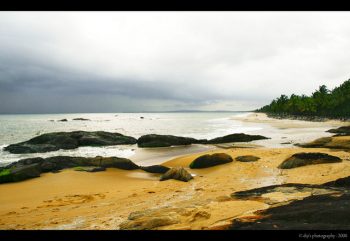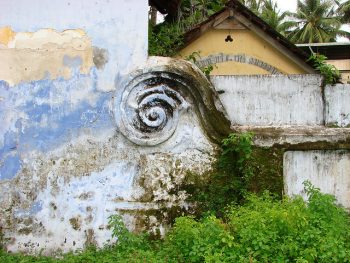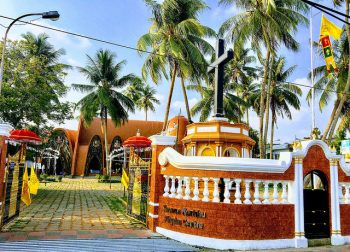Portuguese in Hindi (Part 1): A Tale of Trade, Travel and Cultural Tension Posted by Rachael on May 21, 2017 in Hindi Language, Uncategorized
For almost eight months now, I have been learning Portuguese on my own. As I’ve mentioned in previous blogs, Hindi has been influenced by many other languages, and these were oftentimes those of merchants who came to the subcontinent to trade in its rich natural resources. Portuguese is one such language that has influenced Hindi through South Indian languages with which it came in direct contact as well as Arabic (Arab merchants were trading in the subcontinent around the time that the Portuguese first arrived there). Knowing the source language of a word in Hindi can help tremendously in determining that word’s gender; because Hindi is somewhat of a mishmash of different languages, it is sometimes dangerous to make hard and fast rules as to the gender of a certain word if you don’t know that word’s source language because each source language has its own rules for determining gender. For example, most people would say that you determine the feminine gender in Hindi by the addition of an -इ (short “i”) or an -ई (long “i”) to the end of a word, but that rule doesn’t work for words like पानी/paani (water, masc.), आदमी/aadmi (man, masc., from Arabic) and हाथी/haathi (elephant, masc.). This rule also doesn’t work for some words that come from Sanskrit, like भाषा/bhaasha (language, fem.) and आशा/aashaa (hope, fem.), which end in a -आ (long “a”) usually associated with masculine nouns. However, though Hindi rules (and exceptions) of gender could be discussed at length, this blog (divided into three parts) is devoted to a different topic: the fascinating history of Portuguese’s influence on Hindi!
Major Portuguese (पुर्तगाली, purtgaali, adj.) interaction with the subcontinent began on May 20th, 1498, when Vasco de Gama arrived by ship (नाव/nav, fem. noun) in Calicut (Kozhikode) in the modern-day South Indian state of Kerala. During that visit, the Portuguese initiated trade (व्यापार करना/vyaapaar karnaa or लेन-देन करना/len-den karnaa) when they invited native fishermen onboard and bought some of their wares. On the advice of another, non-Portuguese merchant (व्यापारी/vyaapaari), Gama sent a group of his men to the city (शहर/sheher, masc. noun) of Ponnani (also in Kerala) to introduce themselves to Calicut’s Hindu ruler, the Zamorin (in Portuguese, this hereditary title is known as “Samorim”). Provoking the ire of the Arab merchants already there, who were one of the Portuguese’s main sources of competition for trade (which partly explains the great number of Arabic words that exist in Portuguese and Hindi), Gama was successful in obtaining a letter from the Hindu ruler permitting he and his men to take part in trade; but, unfortunately, the Portuguese were not able to pay custom duties as well as the gold (सोना/sonaa, masc. noun) required to purchase the Zamorin’s goods. Angered at the Portuguese’s lack of funds, Calicut officials apprehended some of Gama’s men in an attempt to force payment; when Gama learned of this, he seized fishermen and other natives in retaliation. Despite these unsavory occurrences, the voyage (यात्रा/yaatraa, fem. noun) itself was a success as Gama returned to Portugal with goods worth sixty times the cost of the expedition.
The next prominent Portuguese figure to make his mark on the subcontinent was Pedro Álvares Cabral; en route to India, he sailed to Brazil as well, which was significant as it was the first time Europeans had set foot in Brazil to date (1500). Once in India, he aimed to trade in pepper (काली मिर्च/kaali mirch, fem. noun) and other spices (मसाला/masaalaa, masc. noun) and was able to establish a factory (कारख़ाना/kaarkhaanaa, masc. noun) in Calicut in 1500. Apparently taking a dislike to the Portuguese, the natives later attacked the factory and killed more than 50 Portuguese. In revenge (बदला/badlaa, masc. noun), Cabral took ten Arab merchant ships by force that were anchored in the harbor (बंदरगाह/bandargaah, masc. noun), killed their crews, stole their goods and set the ships on fire. He also attacked Calicut with cannons and other weaponry for an entire day as payback for the destruction of the factory and the loss of Portuguese life. In the end, however, Cabral was successful in negotiating treaties with rulers in Cochin (Kochi, in the state of Kerala) and Cannanore (or Kannur, also in Kerala).
Later, in 1505, Francisco de Almeida became the Portuguese Viceroy of India with the stipulation that he establish four forts (क़िला/kilaa, masc. noun) on the Southwestern Indian coast to protect Portuguese trading interests and wealth (धन/dhan, masc. noun) in India; in Cannanore (Kannur), he established St. Angelo Fort with the cooperation of the local ruler, Fort Anjediva on Anjadip Island (also Anjadiv or, in Portuguese, Ilha de Angediva) and Fort Manuel in Cochin (Kochi), to name a few. In a relationship with the Portuguese that was generally adversarial, the Zamorin tried to attack them at sea in 1506, but Lourenço de Almeida, Francisco’s son, won the battle (लड़ाई/laraai, fem. noun) of Cannanore (located at the harbor of Cannanore, obviously a strategic spot for trading), which effectively dampened the Zamorin’s morale. In spite of his prowess in warfare, Lourenço was eventually killed in an intense battle at sea against the forces of the Mameluk Egyptians and Gujarat Sultanate at Chaul and Dabul (both of these locations are in present-day Maharashtra) during the Battle of Chaul. Nevertheless, these oppositional forces later came under the control of the Portuguese at the Battle of Diu (Diu is located on Diu Island near Gujarat).
Stay tuned for the second part of this historical saga as well as a third part of this blog, which will discuss the fascinating journey of Portuguese words into Hindi!
शब्दावली की सूची/Shabdaavali ki Soochi (Vocabulary List):
- पुर्तगाली/purtgaali (adjective and noun): Portuguese (people, language, culture, etc.). “Portugal” in Hindi is पूर्तगाल/poortgaal. Example sentence: मैं कुछ पुर्तगाली लोगों को जानती हूँ जो गोवा (या गोआ) में रहते हैं/Main kuch purtgaali logo ko jaanti huun jo Govaa (ya Goa) me rehte hain (I know some Portuguese people who live in Goa).
- नाव/naav (fem. noun): boat or ship. Example sentence: पुराने ज़माने में, पुर्तगाली लोग नाव से इंदिया पहुँच गए/Puraane zamaane me, purtgaali log naav se India pahunch gaye (In the olden days, Portuguese people arrived in India by boat).
- व्यापार करना/vyaapaar karnaa or लेन-देन करना/len-den karnaa (verb): to trade or do business. Example sentence: हमारा परिवार व्यापार करने से (या लेन-देन करने से) अपने पैसे कमाते हैं/Humaaraa parivaar vyaapaar karne se (ya len-den karne se) apne paise kamaate hain (Our family earns money by trading/doing business).
- व्यापारी/vyaapaari (masc. noun): businessman or trader. Example sentence: मेरे पिता जी व्यापारी हैं और, हर साल, वे ऊंटों के लेन-देन करने के लिए पुष्कर जाते हैं/Mere pitaa ji vyaapaari hain aur, har saal, ve uunton ke len-den karne ke liye Pushkar jaate hain (My father is a trader/businessman and, each year, he goes to Pushkar to trade in camels).
- शहर/sheher (masc. noun): town or city. Example sentence: न्यू यॉर्क मेरा मनपसंद शहर है/New York meraa manpasand sheher hai (New York is my favorite city).
- सोना/sonaa (masc. noun): gold. Example sentence: बहुत पहले, लोग चीजें खरीदने के लिए सोने का इस्तेमाल करते थे/Bahut pehle, log cheeze kharidne ke liye sone kaa istemaal karte the (Long ago, people used to use gold to buy things).
- यात्रा/yaatraa (fem. noun): journey, trip or voyage. Example sentence: इस गर्मी, आप इंदिया की यात्रा करेंगे, ना?/Is garmee, aap India ki yaatraa karenge, na? (This summer, you will take a trip/travel to India, right?)
- काली मिर्च/kaali mirch (fem. noun): black pepper (the word मिर्च/mirch, fem. noun, is also a stand alone word that simply means “pepper” and it it usually combined with the words “लाल/laal” (red) and “हरी/haree” (green) to refer to red and green peppers, which are more common than black pepper in Indian cuisine). Example sentence: हमें अपने खाने में बहुत ज़्यादा काली मिर्च पसंद नहीं है/Hame apne khaane me bahut zyaada kaali mirch pasand nahin hai (We don’t like too much black pepper in our food).
- मसाला/masaalaa (masc. noun): spice. You have probably heard of गरम मसाला/garam masaalaa (literally meaning “warm spice,” which is a mixture of spices very common in North Indian and Bengali cuisine). Example sentence: तुम खाना पकाते वक़्त कड़ाही में बहुत मसाले डालते हो; बहुत स्वाद है!/Tum khaanaa pakaate vakt karaahi me bahut masaale dalte ho; bahut svaad hai! (You put a lot of spices in the pot while cooking; it’s very tasty!)
- कारख़ाना/karkhaanaa (masc. noun): factory. Example sentence: मेरी माता जी और बड़ी बहन कारख़ाने में काम करती हैं/Meri maataa ji aur bari behen karkhaane me kam karti hain (My mother and older sister work in a factory).
- बदला/badlaa (masc. noun): revenge. If you want to say, “to take revenge,” this is expressed as बदला लेना/badlaa lenaa in Hindi. Example sentence: कुछ लोगों को बदला लेने में बहुत मज़ा आता है/Kuch logo ko badlaa lene me bahut mazaa aataa hai (Some people really enjoy taking revenge).
- बंदरगाह/bandargaah (masc. noun): harbor or port. Example sentence: हमें अपनी नाव हमेशा बंदरगाह में रखनी पड़ती है/Hame apni naav hameshaa bandargaah me rakhni parti hai (We must always keep our boat in the harbor).
- क़िला/kilaa (masc. noun): fort. Example sentence: मैं जयपुर में बहुत सारे क़िले देखने गयी/Main Jaipur me bahut saare kile dekhne gayi (I went to see a great deal of forts in Jaipur).
- धन/dhan (masc. noun): wealth. Example sentence: मेरे परिवार के पास बहुत धन है/Mere parivaar ke paas bahut dhan hai (My family has a lot of wealth).
- लड़ाई/laraai (fem. noun): battle or fight. Example sentence: भाइयों और बहनों में लड़ाइयाँ बहुत आम बात है/Bhaiyon aur beheno me laraaiyaan bahut aam baat hai (Amongst brothers and sisters, fights are a very common thing).

Build vocabulary, practice pronunciation, and more with Transparent Language Online. Available anytime, anywhere, on any device.






